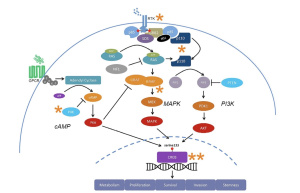What is Glioblastoma?
Glioblastoma (GBM) is the rapid overgrowth of cells in the brain or spinal cord. These brain tumors affect around 12,000 American citizens per year and are incredibly difficult to treat. Treatment options such as chemotherapy and radiation do not cure this form of cancer, but can help to slow the growth of the tumor and invasive surgery is often required. GBM is highly invasive to neighboring brain tissue, but is unlikely to metastasize beyond the brain or central nervous system.
Tumor Development
Cancerous, or malignant, tumors can develop from genetic disorders, age, irritants (smoking, radiation), or environmental factors. Once a mutation is created in a cell from one of these factors, the cell is triggered to divide and multiply at a rapid rate. Additional mutations may occur, in which we see metastasis or the bodywide spread of tumors.
Signaling Effects on GBM
MAPK, PI3K, and cAMP signaling pathways all play a key role in GBM.
MAPK
The MAPK pathway is activated by the binding of growth factor ligands to their corresponding receptor tyrosine kinase (RTK) receptor. When the ligand binds, the RTK is dimerized and autophosphorylates which leads to recruitment of adaptor proteins to the receptor which begins an activating cascade of Ras, then RAF, MEK, and finally MAPK is activated. MAPK contributes to cell proliferation and survival. In GBM, MAPK signaling is over-activated.
PI3K
The PI3K pathway is activated by ligand binding to its corresponding RTK, the receptor is dimerized and phosphorylated. PI3K is then recruited to the receptor. A receptor subunit converts PIP2 to PIP3 which causes AKT to be phosphorylated and promote cell survival and proliferation. In GBM, PI3K signaling is over-active.
cAMP
cAMP signaling begins with the binding of a ligand to a G-protein coupled receptor (GPCR). This causes the alpha subunit of the G-protein to activate adenylyl cyclase which converts ATP to cAMP. cAMP signaling interacts with MAPK by the activation of protein kinase A (PKA) which inhibits the MAPK pathway, and PI3K pathways previously mentioned. This convergence is shown below.

cAMP levels and tumor malignancy have an inverse relationship, meaning that cAMP levels are low in GBM. It is shown that increasing cAMP levels can inhibit growth and differentiation and promote apoptosis in GBM cells.
Treatment
Recalling that MAPK and PI3K signaling is elevated in GBM, it can be concluded that inhibiting these pathways can be a great start in treating GBM. Increasing cAMP is one way, since, as previously stated, PKA inhibits MAPK signaling. Buparlisib is a PI3K inhibitor that is currently used to treat breast cancer and GBM, and Venurafenib is a MAPK inhibitor that is currently used to treat late-stage melanoma. However, GBM is incredibly prone to drug resistance due to the multiple signaling pathways it utilizes – when one pathway is blocked, the cancer finds a way around it. Combining drugs can prevent this circumvention by inhibiting multiple pathways at once. Consequently, toxicity can occur with such combination, so it must be researched and monitored thoroughly.
There is hope for patients diagnosed with GBM. Understanding these signaling pathways is a big leap in the future treatment of this cancer, and hopefully this knowledge is enough to improve the outcome of those affected by this disease.
References
https://www.mayoclinic.org/diseases-conditions/glioblastoma/cdc-20350148
https://www.ncbi.nlm.nih.gov/books/NBK9963/#:~:text=Tumors%20are%20initiated%20by%20mutations,development%20of%20some%20human%20cancers.
https://www.sciencedirect.com/science/article/abs/pii/S0898656819300208?via%3Dihub
